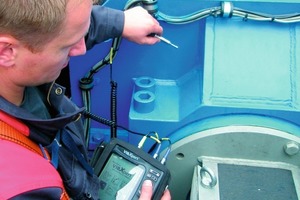Measuring noise levels
European legislation has reduced allowable noise levels by 5 dB and requires machine and system manufacturers to provide information about noise radiation. Machine operators are required to purchase low noise machines and should monitor noise levels. Noise from machines can stem from unknown sources. It is important to know what noise levels can be found in the system and what causes them. Pruftechnik Condition Monitorng performs acceptance measurements of noise emissions and compares the results with the latest standards. Measurements are made with the data analyzer Vibxpert (Fig.) and evaluated with DBSpectra and the software Omnitrend. Dominant noise sources can be identified using third octave or narrow band spectra. “Achievable noise reductions, e.g. in gear drives, can be up to 5 dB: through measures on housings, up to 7 dB: through measures on rotors, toothing and housings and up to 10 dB: through secondary noise shields or enclosures” says Dr. Edwin Becker, Manager Service and Diagnostic Center.
www.pruftechnik.com





